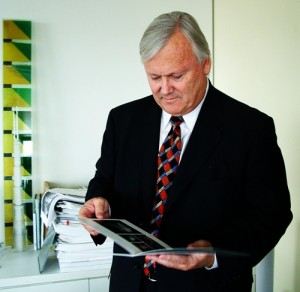By Kenneth L R. Patchen www.lakeforest.suntimes.com
Although architecture may be about glass and steel, when Lake Forest resident Adrian Smith talks about his profession, he does so in terms of emotion and spirit.

“When I came to Chicago during my college years, I was impressed by the skyline and the idea that humankind could make our own mountains out of buildings. I wanted to be part of that,” said Smith, architect of the world’s tallest building, who will be interviewed by journalist Bill Kurtis in the second annual Local Legends program hosted by the Lake Forest-Lake Bluff Historical Society Oct. 29 at Gorton Community Center.
Smith’s accomplishments in architecture include the Burj Khalifa, the world’s tallest building at 2,723 feet, in Dubai; Canary Warf Master Plan, London; Jin Mao Tower, Shanghai; and plans for Millennium Park and Trump International Hotel &Tower in Chicago. For many of these projects, Smith, 68, was working at Skidmore Owings and Merrill, SOM, but he is now name partner of Adrian Smith + Gordon Gill Architecture in Chicago.
Decades before any of this, Smith was a child on California beaches building sandcastles as tall as he could make them. The interests of his youth led him to a mechanical drawing class in high school where his first drawing displayed a 40-story skyscraper. Frank Lloyd Wright was his first role model, and SOM’s Bruce Graham became the second. Early on, Wright had opened his mind to the profession. Graham taught him architecture’s science and the importance of proportions.
Projects too influenced him.
“In the late 1970s, we did a project in Mexico in which we were associated with a third great role model, Ricardo Legorreta, who introduced us to the concept of contextualism,” Smith said. “For me, this meant that a building should have a relationship to its surrounding context and draw from the culture and character of the place for which we are designing. The nature of the site, the climate, wind and soil conditions were all to be factored into the design of the project as well.”
‘Interpret and honor’
This extended to the use of local construction materials.
“In these ways, I try to interpret and honor the societies that my buildings serve, to forge a unique dialogue between culture and place, and to foster a strong connection to the people who see and use my buildings,” he said.
Today, his design principles now include the use of local energy sources from earth, wind and sun.
Wind has been a major resource and challenge for his buildings. Tall buildings such as the Burj Khalifa in Dubai, he said, and a recent assignment for Kingdom Tower in Jeddah, Saudi Arabia — poised to be the tallest building in the world once completed — must confront the impact of wind resistance. Wind builds vertically near a tall building, which can cause lateral movement in the structure felt by inhabitants.
“To combat this problem,” Smith said, “we look for ways to confuse the wind, as we say, and reduce the buildup of the (vertical wind patterns). With Burj Khalifa, we addressed the problem by developing a stepped pattern of set backs. With Kingdom Tower, we sloped the building, which is slightly more expensive to build because each floor plate is slightly smaller than the one directly below it.”
The opening of Burj Khalifa in 2010, he describes as “one of the most thrilling moments of my career.
“My intent, ultimately, (with Burj Khalifa) was to lift the spirits of a nation and a culture, and to bring joy and inspiration to its citizens. I think that Burj Khalifa has fulfilled that mission.” More info














